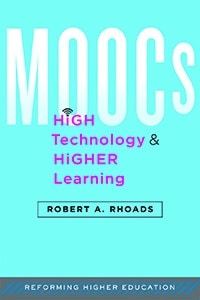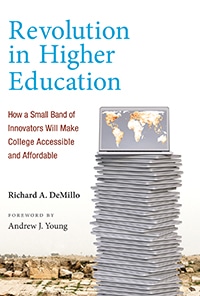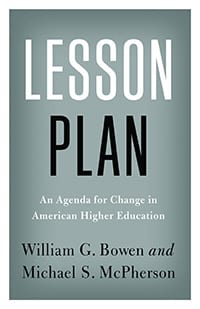Confronting the Crisis in Higher Ed
Review of
MOOCs, High Technology, and Higher Learning
Baltimore, MD: Johns Hopkins University Press, 2015, 168 pp.
Revolution in Higher Education: How a Small Band of Innovators Will Make College Accessible and Affordable
Cambridge MA: MIT Press, 2015, 334 pp.
The War on Learning: Gaining Ground in the Digital University
Cambridge, MA: MIT Press, 2014, 302 pp.
Reengineering the University: How to Be Mission Centered, Market Smart, and Margin Conscious
Baltimore, MD: Johns Hopkins University Press, 2016, 288 pp.
Lesson Plan: An Agenda for Change in Higher Education
Princeton, NJ: Princeton University Press, 2016, 163 pp.
It is hard to believe that only four and a half years ago, the New York Times proclaimed 2012 “The Year of the MOOC.” What a difference a day makes. Three of the five books covered in this review take the MOOC, or massive open online course, phenomenon and the revolution that it seemed to promise as their jumping-off point. But digital learning technology, and the discourse about it, are moving so fast that even these careful, well-intentioned books can already seem somewhat dated. All of the books share a sense of crisis in higher education—of swiftly changing economics, technology, and social context—and of an urgent need for reform. Yet the argument that some pundits make—that the mass availability that digital learning technologies seem to offer will solve the cost crisis in higher education—is far too facile, as the best of these books recognize.

In MOOCs, High Technology, and Higher Learning, Robert A. Rhoads places the OpenCourseWare (OCW) movement (which includes the development of MOOCs) into a historical and organizational context. Indeed, one of the many merits of Rhoads’s book is his sociological analysis of the OCW phenomenon. He argues that the organizational system that developed in the OCW and MOOC movements arose within the context “of high demand for higher education, reduced or stagnant governmental funding, advances in Web technologies, and a powerful mix of public good and private enterprise interests.” He is particularly good at probing the complexity of public and private ambitions in the two movements—the revolutionary purpose some saw them serving (by increasing higher education access) and opportunities for profit the new industry offered.
Rhoads’s distinctions between kinds of MOOCs are especially helpful. He distinguishes between xMOOCs, which are essentially webcast versions of classroom courses, and cMOOCs, which have connective and interactive elements. Rhoads is critical of xMOOCs, arguing that there is no strong evidence that they represent an improvement over face-to-face instruction. Rhoads is committed to the work of the Brazilian educational theorist Paulo Freire. As a Freirian, Rhoads puts democratic dialogue at the center of education, in which students engage in the process of knowledge critique and construction, learning political engagement in the process. By their very nature, xMOOCs do not contain such dialogue, whereas cMOOCs can.
Rhoads is particularly interesting on the problems created by the ways in which elite universities have dominated the OCW and MOOC landscape, although he could probe this phenomenon even more deeply than he does. What were the motives of places like Harvard, MIT, Yale, and Columbia in investing so many resources in MOOCs, from which it would seem they would have little return? But Rhoads asks important questions: “Do we really want superstar faculty from elite universities teaching masses of students at underfunded colleges and universities through the use of recorded lectures? Is brick-and-mortar education to be reserved for the wealthiest of students while the rest are to be ‘MOOC’ed’?” He is particularly alert to the implications of the MOOC movement for diversity and for faculty life and labor, calling for careful attention to both of these subjects.
Rhoads is an extremely good writer, and MOOCs, High Technology, and Higher Learning is a useful book. Reflecting the time of its composition, the book tends to focus on the stand-alone course, developed by a single professor, for an undergraduate audience. He gives little attention to the burgeoning market for online professional degrees and certifications, some low residency, some entirely digital in their delivery. Nonetheless, the book has much to offer anyone seriously interested in digital learning technologies. Rhoads provides many useful policy recommendations about the levels of technological skill and content-based knowledge one might reasonably expect of particular populations of students, about diversity considerations, and about faculty labor and engagement. The book is full of helpful distinctions and probing questions, and it is not one page longer than it needs to be—a rare distinction.

The same, unfortunately, cannot be said for Richard A. DeMillo’s Revolution in Higher Education: How a Small Band of Innovators Will Make College Accessible and Affordable. DeMillo takes as his starting point the “magic year” of 2012, when his small band of innovators invented the MOOC. Whereas Rhoads is a splitter, DeMillo is a lumper, assimilating many rather different phenomena and projects into a master narrative. The shape of the narrative is familiar: “Colleges and universities are in financial crisis,” DeMillo writes. “Tuition rises inexorably. Graduates of reputable schools often fail to learn basic skills, and many cannot find suitable jobs. Meanwhile student-loan default rates have soared while the elite Ivy and near-Ivy schools seem remote and irrelevant.”
To rescue us from this terrible predicament comes a band of entrepreneurs who bring the technology revolution to higher education. Although DeMillo’s book is both wordy and digressive, it assimilates all of its anecdotes and figures into a breathless heroic narrative in which a group of pioneers will rescue higher education from itself. The book is full of melodramatic reportage but little differentiating analysis. DeMillo doesn’t probe why some projects—such as Columbia’s Fathom, the early-2000s online learning experiment that lasted less than three years—fail. And he assimilates quite different enterprises, such as Coursera and the Minerva Project. He takes all of his pioneers at face value.
DeMillo is a bit of a magpie. His book has all kinds of anecdotes and pieces of education history, including the invention of the blackboard, Stanley Fish’s transformation of the Duke University English Department, and Edwin Slosson’s 1910 effort to rank colleges and universities, making the book both sprawling and single-mindedly didactic. For example, he uses the nineteenth-century introduction of the blackboard as an illustration of technological revolution and the hype cycle that accompanies it; he then gives us two pages on the history of the railroad in England to make a similar point, all of this to provide evidence for the transformational impact of technology in higher education.
Technology indeed is having and will continue to have a transformational impact on higher education with consequences for its structure that are difficult to anticipate. There is all the more need, therefore, for careful analysis and differentiation of the many projects and ventures in this space. Despite its prophecies of the future, DeMillo’s book is oddly dated; it seems a product of the year of the MOOC, and hasn’t moved beyond it.

Elizabeth Losh, the author of The War on Learning: Gaining Ground in the Digital University, clearly could not have read DeMillo’s book (they were published the same year), but it would have given her rich material for her analysis. Losh defines herself as a scholar of “digital rhetoric,” and she analyzes not only technological innovations in teaching and learning, but the rhetoric about them. Losh is a skeptic about what she sees as inflated claims for technological solutions to problems in teaching and learning. “The folly of overvaluing innovation” is one of her main themes.
She turns a critical eye to MOOCs, gamification, badge systems, and iPad distribution, citing empirical research that raises questions about their effectiveness in enhancing learning. She spends a lot of time on failures, trying to understand why various digital tools have not realized the benefits that have been claimed for them. However, she is not a Luddite. She’s hopeful about the opportunities that technologies present for learning, but resistant to totalizing claims and grand visions.
Like Rhoads, Losh puts dialogue at the center of her philosophy of learning. She believes that education is a process, not a product; it must be socially situated, and interactional. She calls herself “a conscientious objector in the war on learning,” waged both by those who seek to use technologies to command and control students and by the advocates of DIY education, or “unschooling,” who seek to defund public education. Her critique of MOOCs resembles Rhoads’s critique: that MOOCs are didactic narrative structures devoid of dialogue. In a lively and amusing analysis, Losh contrasts the success of online cheating how-to videos in subverting conventional tests, observing that what’s right with YouTube culture is that it encourages “participation, creativity, subversion, and satire.”
Losh’s deconstruction of the term “digital natives” is particularly interesting. She argues that the cultural clichés on which the term relies—that all young people have access to networked digital technologies and know how to use them, that they are all connected by a common culture and a set of common practices, and that they all intuitively and easily master software—are both false and destructive, and lead to disenfranchisement. To expose this myth of the digital native, Losh repeatedly urges empirical study of digital learners and learning.
She asks, “How can we influence the digital university to be more inclusive, generative, just, and constructive?” She articulates six principles to answer her question: observing the golden rule in decisions about instructional technology by not employing knowledge-sharing methods that faculty themselves would find highly intrusive; having faculty and students use the same tools; preserving the value of old technologies; making digital learning joyful; making the occasion serious; and not embracing novelty as a value in and of itself. Like DeMillo’s book, Losh’s has its polemical moments, but it seeks to embrace the messiness of a movement in very rapid evolution, tries to understand failures as well as successes, and seeks to derive principles from both.

William F. Massy’s Reengineering the University: How to Be Mission Centered, Market Smart, and Margin Conscious is not fundamentally about the impact of digital technologies on higher education. As its title implies, the book is about institutional change and how best to achieve it. Massy believes that there is a lot wrong with the contemporary university, including massive failures in the marketplace that keep students from making optimal choices about which university to attend and that do not provide appropriate institutional incentives either for quality improvement or cost control. Other problems include the loss of political confidence in higher education; threats to traditional universities, which Massy describes as “industrialized higher education”; and lack of sufficient reform efforts by administrators, board members, and faculty.
Drawing extensively from business administration and from microeconomics, Massy’s language may make the book seem too wonkish for some and too corporate for others. But these would be superficial judgments. In his preface, Massy quotes a reviewer of his manuscript who describes him as “[h]alf hopeless romantic about the value and high purposes of higher education and half pragmatic engineer focused on cost, efficiency, and metrics.” Massy feels the reviewer got it right, and I agree.
Massy profoundly values the unique character and culture of universities, with their on-campus student bodies, faculty resources, research and scholarship, and nonprofit organizational form. And he understands their complexity: “They produce multiple and nuanced outputs, use highly specialized and often autonomous inputs, and pursue nonprofit goals that are not easily quantified or even described coherently in subjective terms.” Indeed, because he so values the university, he is all the more impatient with its resistance to change, its rigidities and complacencies.
Massy believes that the flaws in contemporary higher education fall into five main categories: the over-decentralization of teaching; “unmonitored joint production” of teaching and research; dissociation of educational quality from cost; lack of good learning metrics; and over-reliance on market forces. Universities are perhaps unique among organizations that offer a creative service to their consumers in the degree of independence that faculty—the providers of this service—have in their work. Massy puts it this way: “decisions about how much [teaching and research] to produce lie mainly in the hands of individual professors, with relatively little oversight from department chairs—let alone deans and provosts.” In the university that Massy envisions, there would be focused attention on the continuous improvement of teaching, dependent on learning metrics. (Massy doesn’t have much to say about research.) He advocates far more rigorous measurement of teaching activity and putting such teaching activity data in the hands of faculty.
The topics covered in Massy’s chapters give a good sense of his focus—the reengineering challenge, the new scholarship of teaching, the cost of teaching, and financial planning and budgeting. He argues for a culture of continuous improvement, in which peer review is built into all reengineering efforts. His chapter on financial planning and budgeting is particularly useful, both in the dashboards it provides for presenting financial data and in its trade-off model for balancing mission and margin. I’m not certain that any reader not engaged in some way in running a university will follow Massy through his detailed exposition of tools and metrics, but for those readers who are so engaged, Massy’s book offers much valuable insight.

Lesson Plan: An Agenda for Change in Higher Education, by William G. Bowen and Michael S. McPherson, has a different audience in mind. This short text—only 140 pages—is perhaps the wisest of recently published books on higher education. The book does not pretend to original research; rather, it collects together what is known and can be inferred about the current situation in American higher education. Like Massy, the authors believe that university leaders and boards are not doing enough to come to grips with the challenges higher education is facing.
Not surprisingly—Bowen and McPherson are economists—Lesson Plan is particularly insightful about the cost of higher education. The authors argue that the central question about college finance is not how to make college “free” (or appear to be free), but how to share the costs equitably. They observe that paying for college has always been a joint responsibility of families, governments, and philanthropy; the question is how to share this responsibility fairly. They differentiate cost reduction from cost shifting, noting that costs have clearly shifted in recent decades from the state to the family, consequently limiting college opportunities for the least well-off.
Despite their critique of this cost shifting, the authors do not think affordability is the biggest issue in higher education today. Completion rates and the length of time to achieve a degree, particularly among students of low socioeconomic status, are more significant problems. The degree attainment gap between the wealthy and the poor is increasing and the rungs of the ladder to success have moved further apart. This is a consequence, in part, of reductions in public funding. Classes are less available, particularly at resource-challenged institutions, and student employment has risen dramatically as a result. The authors make a number of compelling recommendations about federal financial aid policy, arguing that it should be tied to timely college completion and to student success.
Ultimately, Bowen and McPherson argue that faculty roles in making decisions about resource allocation and in determining teaching methods need to be rethought. “Advances in technology require investments in teaching technologies and decisions about staffing patterns that more and more often transcend departmental and even institutional boundaries,” they note. “Aspects of governance structure need to evolve away from vertical models, centered on departments, to horizontal models that focus on achieving a combination of educational effectiveness and cost efficiencies.” They end their book with a call for stronger leadership on the part of university presidents and boards. Bowen and McPherson have written a wise book, and a hopeful one, which engages the many challenges facing higher education while charting a path forward.
